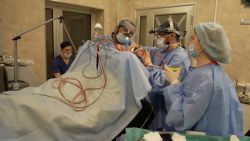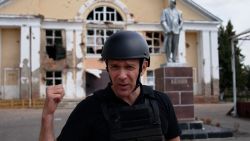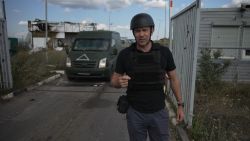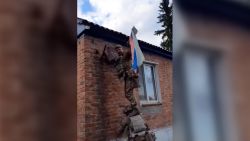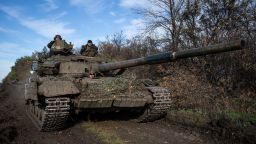As the young soldier lies motionless in the machine, a group of doctors huddle over a computer in an adjoining room.
The images from the CT scanner show shrapnel lodged deep in the left-hand side of the man’s brain. “He needs urgent surgery,” 37-year-old neurosurgeon Oleg Serkiz says.
As one patient is prepared for the operating table, paramedics in military fatigues deliver another soldier on a stretcher, and then another – a constant stream of Ukraine’s fittest bodies now torn by metal and punctured by bullets.
These men were rushed from the frontline to a specialist trauma hospital in the city of Kramatorsk on Wednesday afternoon after being wounded in the bloody battle for the eastern town of Bakhmut. Only hours earlier, they were the adrenaline-pumped vanguard of the Ukrainian army’s attempt to take on the Russian troops – among them mercenaries that hold much of the area. Now they wait, cold and pale, for their turn on the operating table.
Chief surgeon Dr. Vitaly Malanchuk is often the first to assess the men’s injuries.
“We’re dealing with shrapnel wounds and gunshot wounds,” he says. “People can have severed limbs, with large facial defects… Plus there’s polytrauma, where different organs are involved.”
“Polytrauma” is what a lay person would call many holes in the body.

The surgical team has treated around 100 patients a day over the past few weeks, and operated on around half of them. It’s intense work, performed under the threat of missile attacks from Russian-held territory just 30 kilometres away. The pace of arrivals mean there’s no time to shelter when air raid warnings sound here. Tape on the windows appears the only attempt to mitigate damage from any blast.
Crucial to the surgeons’ work is a single CT scanner that shows surgeons the damage to a patient’s brain and spinal cord. It would usually run 15 or 20 scans per day. Now, it processes 70 or 80. There is a “screaming need” for a replacement, Dr. Malanchuk says. They have located a used scanner for sale in the west of Ukraine that costs about 120,000 US dollars. The hospital’s administrators here have raised about $60,000 but are appealing for help with the rest.
The soldiers that can walk into the hospital unaided know they are lucky. A 35-year-old, who goes by the callsign “Duck”, was shooting mortars at the Russians on Wednesday morning when the enemy returned fire. “I got hit in the leg and my mate in the arm,” he said. “If I’m sitting here, I’m lucky.”
He said he will visit his family for a week and then wants to return to the fight for Bakhmut, which he describes as “the most hellish section of the front. The Russians are throwing all their forces at it… [but] we’re hanging in there.”
Another solddier, 26-year-old “Czech,” was alongside “Duck” when they were hit. He describes the battle for Bakhmut as, “Trenches, mud, blood, trenches, mud again, artillery. Trench warfare…. World War I and World War II. Verdun, the Somme… something like that.”

“Czech” says his unit has weapons from NATO allies but not enough to prevent injuries at this scale. “Not enough at all… not enough tanks, aviation, armored vehicles so [that] we can go after their equipment and not get such a big hit with artillery. The West gives Ukraine weapons for guerrilla warfare. But we are not fighting as partisans, we are fighting as a regular army where two fronts meet.”
In this seemingly endless war of attrition, doctors, like soldiers, are spurred on by success where they find it.

“You understand that you are exhausted, you understand that there is a process of internal burnout,” the Dr. Malanchuk said. “But to be honest, in some ways we do get energy from it. Our eyes really light up when we see those patients who thank us, who are recovering, who are after surgery… And that alone makes us not get tired, go forward and most importantly it accumulates energy. It seems that you are exhausted, and then the next patient comes along and the process does its work again.”


